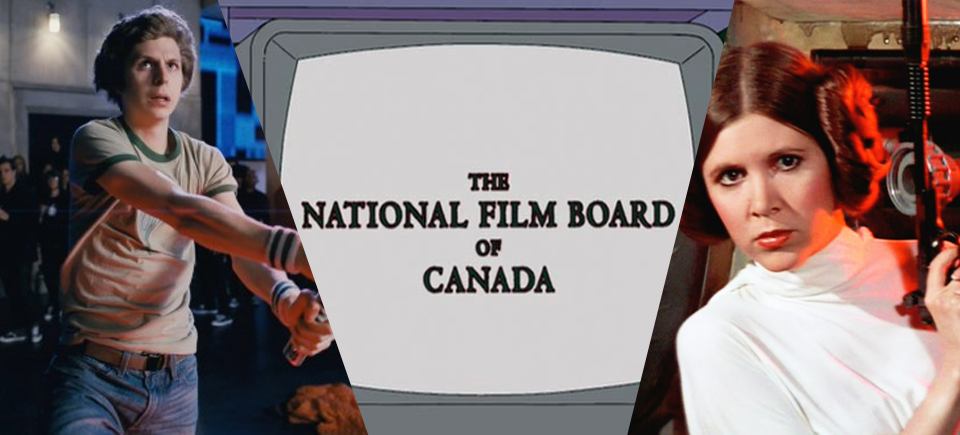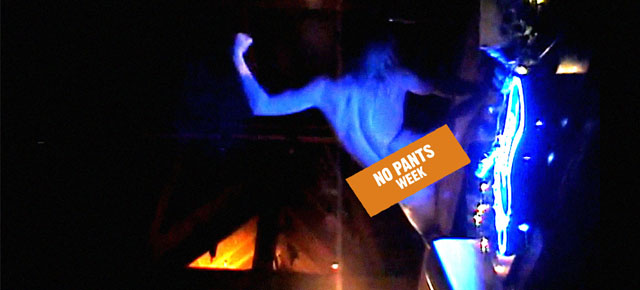
Let’s keep warm by the electronic fireplace with 5 films about TV
Let’s keep warm by the electronic fireplace with 5 films about TV
Telly, boob tube, idiot box, babysitter, electronic fireplace…
Those are just some of the slang terms for TV that have emerged over the past almost-century since television was born. What has TV been to us and what has it done for us? Let’s find out with a bunch of curious, raucous, and weird little films about TV on NFB.ca this week!
New on NFB.ca: Once upon a Prime Time
We just recently digitized and uploaded Once upon a Prime Time, a zany short film from the ’60s. It’s a hilarious and occasionally even disturbing tale of a desperate housewife whose entire family is obsessed with TV. At first, she’s simply annoyed. But suddenly, strange things—strangely TV-like things—start to happen around the house. If she can’t beat ’em, will she join ’em?
Once upon a Prime Time, Bernard Devlin, provided by the National Film Board of Canada
Advertising: the gas that fuels the TV fire
Part miniature entertainment machine, part home-invading advertising vehicle, TV has been many things at many different times. From the introduction of live satellite feeds in the early ’60s to the so-called Second Golden Age of TV that we’re living in right now, TV has perpetually changed its relationship with audiences, advertisers, and culture in general.
Advertisers, however, have always had a strong hold on the kind of content produced for TV. And sometimes, the nature and influence of TV advertising can just be… insane. The Bronswik Affair is a witty satire that sends up the devastating effects of television advertising by portraying a fictional conspiracy about the brainwashing of an entire product-hungry public.
Check it out and have a laugh:
The Bronswik Affair, Robert Awad & André Leduc, provided by the National Film Board of Canada
If you want to see something really crazy, though, try out TV Sale, an indescribably wacky series of vignettes that take product placement on TV shows to the extreme. Want to see an ad for something called North American Tragedy and Death? Or a plastic pill-gun called “Cool It” that shoot pellets into your mouth to relieve nervous tension? Delve into the wild world of consumer culture in this super-weird film.
TV Sale, Ernie Schmidt, provided by the National Film Board of Canada
Peter Watkins: the anti-TV aesthetic
In the year 2000, British filmmaker Peter Watkins set out to make an incredibly ambitious project: an almost 6-hour epic film for TV starring mostly non-professional actors about the Paris Commune of 1871 (a key event in the history of the European working class). In the process, NFB documentary filmmaker Geoff Bowie decided to film the process of Watkins’ large-scale project, and the result is the fascinating documentary The Universal Clock – The Resistance of Peter Watkins.
Watkins is committed to resisting hierarchies and established conventions by playing aesthetics in innovative ways; he aims to “develop alternative TV forms and processes”, as he says. When criticizing “the excessively hierarchical producer-audience relationship” that has emerged in TV forms, Watkins says La Commune “gives examples of both egocentric, and open, pluralistic forms.”
“It is amazing,” writes Watkins, “to hear these TV executives confidently stating their ‘universal truths’ about the structure of TV, subsequently standardizing everything which now appears on global TV, and suppressing all alternative work. And thereby revealing their contempt of the audience…”
You can read more about the making of La Commune here, and watch Bowie’s documentary below:
The Universal Clock – The Resistance of Peter Watkins, Geoff Bowie, provided by the National Film Board of Canada
Short, quick, cute, and hilarious
The title of Cecilia Tichi’s book Electronic Hearth: Creating an American Television Culture points to the central status of the television set within the North American postwar home. Tichi describes early marketing campaigns that sold TV sets by convincing homeowners that the TV set enhances the domestic space “and ought to be accorded a prominent position as focal object.”
Part of this “focal object’s” appeal was the family-friendly nature of mainstream broadcast programming, and I’m not talking only about the TV shows. There was also the commercials, public service announcements, and station promos that offered a squeak-clean, idealized version of the world inside a TV set.
Take a look at a few of these adorable and short vignettes in Hors-d’oeuvre. This short collection of 1-minute animations will bring you back to the heyday of broadcast TV. Including programming alerts and safety announcements, these playful clips will tickle you.
Hors-d’oeuvre, Gerald Potterton, Robert Verrall, Arthur Lipsett, Derek Lamb, Jeff Hale & Kaj Pindal, provided by the National Film Board of Canada
That’s it for TV week on NFB.ca! From the playful to the combative to the absurd, we think we’ve given you a pretty thorough tour of all that this “electronic fireplace” has to offer. Happy watching!



